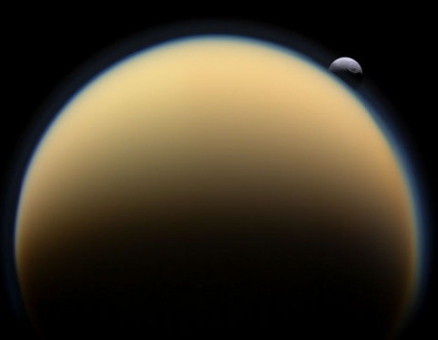Life from the Skies?
?Main Image Explanation: What's that behind Titan? It's another of Saturn's moons: Tethys. The robotic Cassini spacecraft orbiting Saturn captured the heavily cratered Tethys slipping behind Saturn's atmosphere-shrouded Titan late last year. The largest crater on Tethys, Odysseus, is easily visible on the distant moon. Titan shows not only its thick and opaque orange lower atmosphere, but also an unusual upper layer of blue-tinted haze. Tethys, at about 2 million kilometers distant, was twice as far from Cassini as was Titan when the above image was taken. In 2004, Cassini released the Hyugens probe which landed on Titan and provided humanity's first views of the surface of the Solar System's only known lake-bearing moon.
Did Life Fall from the Skies? Lessons from Titan
"… we are children equally of the earth and the sky." (Carl Sagan)
In sci-fi movies, the first stirrings of life happen in a gooey pool of primordial ooze. But new research suggests the action started instead in the stormy skies above.
The idea sprang from research led by University of Arizona's Sarah Hörst. Her team recreated, in the lab, chemical reactions transpiring above Saturn's largest moon, Titan.
"We're finding that the kind of chemistry an atmosphere can do has intriguing implications for life on Earth and elsewhere in the solar system," says Hörst. "Titan's skies might do some interesting chemistry – manufacture the building blocks of life."
Hörst and her colleagues mixed up a brew of molecules (carbon monoxide(1), molecular nitrogen and methane) found in Titan's atmosphere. Then they zapped the concoction with radio waves – a proxy for the sun's radiation.
What happened next didn't make the scientists shout "it's alive!" but it was intriguing. A rich array of complex molecules emerged, including amino acids and nucleotides.
"Our experiment is the first proof that you can make the precursors for life up in an atmosphere, without any liquid water(2). This means life's building blocks could form in the air and then rain down from the skies!"
Titan is unique in our solar system. Dotted with lakes and dunes and shrouded in a thick atmosphere of nitrogen and methane, it's a frozen time capsule of early Earth. While the liquid on Titan's surface is methane instead of water, it's the only body in the solar system other than Earth with liquid on its surface.
"We didn't start out to prove we could make 'life' in Titan's skies," explains Hörst. "We were trying to solve a mystery. The Cassini spacecraft detected large molecules(3) in Titan's atmosphere, and we wanted to find out what they could be."
In hopes of obtaining clues to the mystery molecules, Hörst used computer codes to search the lab results for matches to known molecular formulas. She decided, on a whim, to look for nucleotides and amino acids.
"When I pressed the enter key, I expected a big 'nope, not there.'"
She left for a break, and got a big surprise upon returning.
"The computer was printing out such long lists I thought I must have made a mistake!"
But there was no mistake.
"We had about 5000 molecules containing the right stuff: carbon, nitrogen, hydrogen, and oxygen. We knew we had the elements for organic molecules, but we couldn't tell how they were arranged. It's kind of like legos – the more there are, the more possible structures can be made. And they can be put together in many different ways."
Among the structures identified in the lab experiment so far are five nucleotides found in DNA and RNA, and two amino acids. But she says there could be more amino acids in the mix.
How could Titan's atmosphere generate them?
The answer lies in another Cassini discovery: plumes of water blasting from Titan's sister moon Enceladus. The researchers have good proof that these geysers are the source of oxygen required to kick off the first chain reactions required for life.
"Water spewing across from the plumes gets broken up, releasing hydrogen and oxygen. And the amount of oxygen entering Titan's atmosphere from outside is precisely the quantity needed to make the amount of carbon monoxide detected in that atmosphere."
Then, other chemical reactions(4) occur, producing the heavier molecules Cassini detected. If the lab results are correct, amino acids and nucleotides are in the mix.
"We still don't know for sure what the actual molecules are in Titan's atmosphere," says Hörst, "but there's a distinct possibility that life's precursors are raining down on the surface of Titan."
Picture it: One moon spraying another moon with water to generate the building blocks of life, which fall to the surface in a storm of methane rain.
Real life may be stranger than science fiction, after all.
Author: dauna.d.coulter@nasa.gov?subject=feedback%20on%20Titan Dauna Coulter | Editor: dr.tony.phillips@earthlink.net?subject=feedback%20on%20Titan Dr. Tony Phillips | Credit: Science@NASA
December 30, 2010
